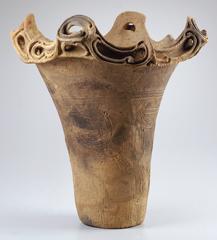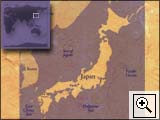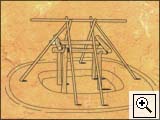
 |
 |
 |
This prehistoric EARTHENWARE pot is an example of some of the oldest pottery found in the world. It probably comes from central Japan, near where Tokyo is today. The deep jar was made during the middle years of a period named Jomon by a 19th century scholar. The culture lasted from 10,500 to 300 B.C. The Jomon culture was not only long-lived, but also widespread; evidence of its existence has been found at over 75,000 sites. It was the first Japanese culture to produce ceramic wares, made in many different forms and styles. Although determining precisely when the earliest Jomon vessels were made is difficult, RADIOCARBON DATING has identified pieces from as early as 10,500 B.C.
In the Middle Jomon period people had to migrate to central forested highlands because of melting Ice Age glaciers that had begun to separate Japan from the mainland. They survived by hunting, gathering, and fishing and used simple tools of wood, bone, horn, or stone. Large villages consisted of pit houses with central heating and cooking areas that emphasized the importance of family unity. The people stored and processed the foodstuffs they gathered, and perhaps even cultivated some of their own crops. The large number of vessels that have been excavated from dwellings throughout Japan suggest the people enjoyed economic stability and enough leisure time to develop crafts that incorporated decoration that wasn't functional, but was a delight to the eye.

Key ideas.
Where does it come from?
What does it look like?
How was it used?
How was it made?
How big is it?
Who Knows?
Additional resources.
